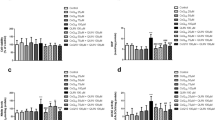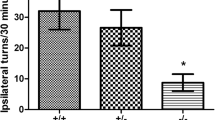Abstract
Quinolinic acid (QUIN) is a toxic compound with pro-oxidant, pro-inflammatory, and pro-apoptotic actions found at high levels in the central nervous system (CNS) in several pathological conditions. Due to the toxicity of QUIN, it is important to evaluate strategies to protect against the damage caused by this metabolite in the brain. In this context, coenzyme Q10 (CoQ10) is a provitamin present in the mitochondria with a protective role in cells through several mechanisms of action. Based on these, the present study was aimed at evaluating the possible neuroprotective role of CoQ10 against damage caused by QUIN in the striatum of young Wistar rats. Twenty-one-day-old rats underwent a 10-day pretreatment with CoQ10 or saline (control) intraperitoneal injections and on the 30th day of life received QUIN intrastriatal or saline (control) administration. The animals were submitted to behavior tests or euthanized, and the striatum was dissected to neurochemical studies. Results showed that CoQ10 was able to prevent behavioral changes (the open field, object recognition, and pole test tasks) and neurochemical parameters (alteration in the gene expression of IL-1β, IL-6, SOD, and GPx, as well as in the immunocontent of cytoplasmic Nrf2 and nuclear p-Nf-κβ) caused by QUIN. These findings demonstrate the promising therapeutic effects of CoQ10 against QUIN toxicity.








Similar content being viewed by others
References
Aaseth J, Alexander J, Alehagen U (2021) Coenzyme Q10 supplementation – in ageing and disease. Mech Ageing Dev 197:111521. https://doi.org/10.1016/j.mad.2021.111521
Abiri B, Vafa M (2021) Impact of coenzyme Q10 on inflammatory biomarkers and its role in future therapeutic strategies. Clin Nutr ESPEN
Achenbach J, Thiels C, Lücke T, Saft C (2020) Clinical manifestation of juvenile and pediatric hd patients: a retrospective case series. Brain Sci. https://doi.org/10.3390/brainsci10060340
Andalib S, Mashhadi-Mousapour M, Bijani S, Hosseini MJ (2019) Coenzyme Q 10 alleviated behavioral dysfunction and bioenergetic function in an animal model of depression. Neurochem Res 44:1182–1191. https://doi.org/10.1007/s11064-019-02761-0
Antunes Wilhelm E, Ricardo Jesse C, Folharini Bortolatto C, Wayne Nogueira C (2013) Correlations between behavioural and oxidative parameters in a rat quinolinic acid model of Huntington’s disease: protective effect of melatonin. Eur J Pharmacol 701:65–72. https://doi.org/10.1016/j.ejphar.2013.01.007
Behan WM, McDonald M, Darlington LG, Stone TW (1999) Oxidative stress as a mechanism for quinolinic acid-induced hippocampal damage: protection by melatonin and deprenyl. Br J Pharmacol 128:1754–1760. https://doi.org/10.1038/sj.bjp.0702940
Biasibetti-Brendler H, Schmitz F, Pierozan P et al (2017) Hypoxanthine induces neuroenergetic impairment and cell death in striatum of young adult Wistar rats. Mol Neurobiol 1–9. https://doi.org/10.1007/s12035-017-0634-z
Braidy N, Grant R (2017) Kynurenine pathway metabolism and neuroinflammatory disease. Neural Regen Res 12:39–42
Braidy N, Grant R, Adams S, Guillemin GJ (2010) Neuroprotective effects of naturally occurring polyphenols on quinolinic acid-induced excitotoxicity in human neurons. FEBS J 277:368–382. https://doi.org/10.1111/j.1742-4658.2009.07487.x
Carter RJ, Morton J, Dunnett SB (2001) Motor coordination and balance in rodents. In: Current Protocols in Neuroscience
Colín-González AL, Luna-López A, Königsberg M et al (2014) Early modulation of the transcription factor Nrf2 in rodent striatal slices by quinolinic acid, a toxic metabolite of the kynurenine pathway. Neuroscience 260:130–139. https://doi.org/10.1016/j.neuroscience.2013.12.025
Colle D, Hartwig JM, Antunes Soares FA, Farina M (2012) Probucol modulates oxidative stress and excitotoxicity in Huntington’s disease models in vitro. Brain Res Bull 87:397–405. https://doi.org/10.1016/j.brainresbull.2012.01.003
Cornelius N, Wardman JH, Hargreaves IP et al (2017) Evidence of oxidative stress and mitochondrial dysfunction in spinocerebellar ataxia type 2 (SCA2) patient fibroblasts: effect of coenzyme Q10 supplementation on these parameters. Mitochondrion 34:103–114. https://doi.org/10.1016/j.mito.2017.03.001
Deniz BF, Confortim HD, Deckmann I et al (2018) Folic acid supplementation during pregnancy prevents cognitive impairments and BDNF imbalance in the hippocampus of the offspring after neonatal hypoxia-ischemia. J Nutr Biochem. https://doi.org/10.1016/j.jnutbio.2018.06.008
El-Aal SAA, El-Fattah MAA, El-Abhar HS (2017) CoQ10 augments rosuvastatin neuroprotective effect in a model of global ischemia via inhibition of NF-κB/JNK3/Bax and activation of Akt/FOXO3A/Bim cues. Front Pharmacol 8. https://doi.org/10.3389/fphar.2017.00735
Ennaceur A, Delacour J (1988) A new one - trial test for neurobiological studies of memory in rats. 1 “ Behavioral data. Behav Brain Res 31:47–59. https://doi.org/10.1016/0166-4328(88)90157-X
Ferreira FS, Biasibetti-Brendler H, Pierozan P et al (2018) Kynurenic acid restores Nrf2 levels and prevents quinolinic acid-induced toxicity in rat striatal slices. Mol Neurobiol 1–12. https://doi.org/10.1007/s12035-018-1003-2
Ferreira FS, Dos Santos TM, Ramires Junior OV et al (2022) Quinolinic acid impairs redox homeostasis, bioenergetic, and cell signaling in rat striatum slices: prevention by coenzyme Q10. Neurotox Res. https://doi.org/10.1007/s12640-022-00484-9
Ferreira FS, Schmitz F, Marques EP et al (2020) Intrastriatal quinolinic acid administration impairs redox homeostasis and induces inflammatory changes: prevention by kynurenic acid. Neurotox Res. https://doi.org/10.1007/s12640-020-00192-2
Ghasemloo E, Mostafavi H, Hosseini M et al (2021a) Neuroprotective effects of coenzyme Q10 in Parkinson’s model via a novel Q10/miR-149-5p/MMPs pathway. Metab Brain Dis 36:2089–2100. https://doi.org/10.1007/s11011-021-00795-4
Ghasemloo E, Oryan S, Bigdeli MR et al (2021b) The neuroprotective effect of microRNA-149-5p and coenzymeQ10 by reducing levels of inflammatory cytokines and metalloproteinases following focal brain ischemia in rats. Brain Res Bull. https://doi.org/10.1016/j.brainresbull.2021.01.013
Guillemin GJ (2012) Quinolinic acid, the inescapable neurotoxin. FEBS J 279:1356–1365
Hargreaves I, Heaton RA, Mantle D (2020) Disorders of human coenzyme q10 metabolism: an overview. Int J Mol Sci
Jamwal S, Singh S, Gill JS, Kumar P (2017) L-Theanine prevent quinolinic acid induced motor deficit and striatal neurotoxicity: reduction in oxido-nitrosative stress and restoration of striatal neurotransmitters level. Eur J Pharmacol 811:171–179. https://doi.org/10.1016/j.ejphar.2017.06.016
Kalonia H, Kumar P, Kumar A (2011) Attenuation of proinflammatory cytokines and apoptotic process by verapamil and diltiazem against quinolinic acid induced Huntington like alterations in rats. Brain Res 1372:115–126. https://doi.org/10.1016/j.brainres.2010.11.060
Kalonia H, Mishra J, Kumar A (2012) Targeting neuro-inflammatory cytokines and oxidative stress by minocycline attenuates quinolinic-acid-induced huntington’s disease-like symptoms in rats. Neurotox Res 22:310–320. https://doi.org/10.1007/s12640-012-9315-x
Komaki H, Faraji N, Komaki A et al (2019) Investigation of protective effects of coenzyme Q10 on impaired synaptic plasticity in a male rat model of Alzheimer’s disease. Brain Res Bull 147:14–21. https://doi.org/10.1016/j.brainresbull.2019.01.025
Kubicova L, Hadacek F, Chobot V (2013) Quinolinic acid: neurotoxin or oxidative stress modulator? Int J Mol Sci 14:21328–21338. https://doi.org/10.3390/ijms141121328
La Cruz VPD, Carrillo-Mora P, Santamaría A (2013) Quinolinic acid, an endogenous molecule combining excitotoxicity, oxidative stress and other toxic mechanisms. Int J Tryptophan Res 5:1–8
Liang Y, Xie S, He Y et al (2022) Kynurenine pathway metabolites as biomarkers in Alzheimer’s disease. Dis Markers
Lowry OH, Rosebrough NJ, Farr AL, Randall RJ (1951) Protein measurement with the Folin phenol reagent. J Biol Chem 193:265–275. https://doi.org/10.1016/0304-3894(92)87011-4
Lugo-Huitrón R, Blanco-Ayala T, Ugalde-Muñiz P et al (2011) On the antioxidant properties of kynurenic acid: free radical scavenging activity and inhibition of oxidative stress. Neurotoxicol Teratol 33:538–547. https://doi.org/10.1016/j.ntt.2011.07.002
Lugo-Huitrón R, Ugalde Muñiz P, Pineda B et al (2013) Quinolinic acid: an endogenous neurotoxin with multiple targets. Oxid Med Cell Longev. https://doi.org/10.1155/2013/104024
Moatti A, Cohen JL (2021) The TNF-α/TNFR2 pathway: targeting a brake to release the anti-tumor immune response. Front Cell Dev Biol
Mor A, Tankiewicz-Kwedlo A, Krupa A, Pawlak D (2021) Role of kynurenine pathway in oxidative stress during neurodegenerative disorders. Cells
Okudan N, Belviranlı M, Sezer T (2022) Potential protective effect of coenzyme Q10 on doxorubicin-induced neurotoxicity and behavioral disturbances in rats. Neurochem Res 47:1280–1289. https://doi.org/10.1007/s11064-021-03522-8
Omidi G, Karimi SA, Rezvani-Kamran A et al (2019) Effect of coenzyme Q10 supplementation on diabetes induced memory deficits in rats. Metab Brain Dis. https://doi.org/10.1007/s11011-019-00402-7
Onaolapo OJ, Omotoso SA, Olofinnade AT, Onaolapo AY (2021) Anti-inflammatory, anti-oxidant, and anti-lipaemic effects of daily dietary coenzyme-Q10 supplement in a mouse model of metabolic syndrome. Antiinflamm Antiallergy Agents Med Chem. https://doi.org/10.2174/1871523020666210427111328
Pallotti F, Bergamini C, Lamperti C, Fato R (2022) The roles of coenzyme Q in disease : direct and indirect involvement in cellular functions
Pamplona FA, Pandolfo P, Savoldi R et al (2009) Environmental enrichment improves cognitive deficits in spontaneously hypertensive rats (SHR): relevance for attention deficit/hyperactivity disorder (ADHD). Prog Neuro-Psychopharmacol Biol Psychiatry 33:1153–1160. https://doi.org/10.1016/j.pnpbp.2009.06.012
Paxinos G, Watson C (2006) The rat brain in stereotaxic coordinates sixth edition by. Acad Press 170:547612. https://doi.org/10.1016/0143-4179(83)90049-5
Pierozan P, Fernandes CG, Dutra MF et al (2014) Biochemical, histopathological and behavioral alterations caused by intrastriatal administration of quinolic acid to young rats. FEBS J 281:2061–2073. https://doi.org/10.1111/febs.12762
Porro C, Cianciulli A, Panaro MA (2020) The regulatory role of IL-10 in neurodegenerative diseases. Biomolecules
Purushothaman B, Sumathi T (2022) 5,6,7 Trihydroxy flavone armoured neurodegeneration caused by quinolinic acid induced huntington’s like disease in rat striatum - reinstating the level of brain neurotrophins with special reference to cognitive-socio behaviour, biochemical and histopathol. Neurosci Res. https://doi.org/10.1016/j.neures.2021.08.003
Ramires Júnior OV, da Alves B, S, Barros PAB et al (2021) Nanoemulsion improves the neuroprotective effects of curcumin in an experimental model of Parkinson’s disease. Neurotox Res. https://doi.org/10.1007/s12640-021-00362-w
Rauf A, Badoni H, Abu-Izneid T et al (2022) Neuroinflammatory markers: key indicators in the pathology of neurodegenerative diseases. Molecules
Rauscher FM, Sanders RA, Watkins JB (2001) Effects of coenzyme Q10 treatment on antioxidant pathways in normal and streptozotocin-induced diabetic rats. J Biochem Mol Toxicol 15:41–46. https://doi.org/10.1002/1099-0461(2001)15:1%3c41::AID-JBT5%3e3.0.CO;2-Z
Salama A, Elgohary R (2021) L-Carnitine and Co Q10 ameliorate potassium dichromate -induced acute brain injury in rats targeting AMPK/AKT/NF-κβ. Int Immunopharmacol. https://doi.org/10.1016/j.intimp.2021.107867
Sanches EF, Arteni NS, Nicola F et al (2013) Early hypoxia-ischemia causes hemisphere and sex-dependent cognitive impairment and histological damage. Neuroscience 237:208–215. https://doi.org/10.1016/j.neuroscience.2013.01.066
Santamaría A, Galván-Arzate S, Lisý V et al (2001) Quinolinic acid induces oxidative stress in rat brain synaptosomes. NeuroReport 12:871–874. https://doi.org/10.1097/00001756-200103260-00049
Sas K, Robotka H, Toldi J, Vécsei L (2007) Mitochondria, metabolic disturbances, oxidative stress and the kynurenine system, with focus on neurodegenerative disorders. J Neurol Sci 257:221–239. https://doi.org/10.1016/j.jns.2007.01.033
Segabinazi E, Gasperini NF, Faustino AM et al (2020) Comparative overview of the effects of aerobic and resistance exercise on anxiety-like behavior, cognitive flexibility, and hippocampal synaptic plasticity parameters in healthy rats. Brazilian J Med Biol Res Rev Bras Pesqui medicas e Biol. https://doi.org/10.1590/1414-431X20209816
Silveira JS, Ramires Júnior OV, Schmitz F et al (2022) Folic acid supplementation during pregnancy alters behavior in male rat offspring: nitrative stress and neuroinflammatory implications. Mol Neurobiol. https://doi.org/10.1007/s12035-022-02724-7
Spindler M, Flint Beal M, Henchcliffe C (2009) Coenzyme Q10 effects in neurodegenerative disease. Neuropsychiatr Dis Treat 5:597–610
Srivastava P, Verma AK, Arya JK, Rizvi SI (2022) Modulatory effect of exogenous coenzyme Q10 on redox and inflammatory biomarkers during aging in rats. Biol Futur. https://doi.org/10.1007/s42977-022-00140-5
Stone TW (1993) Neuropharmacology of quinolinic and kynurenic acids. Pharmacol Rev 45:309–379
Tasset I, Pérez-De La Cruz V, Elinos-Calderón D et al (2010) Protective effect of tert-butylhydroquinone on the quinolinic-acid-induced toxicity in rat striatal slices: role of the Nrf2-antioxidant response element pathway. Neurosignals 18:24–31. https://doi.org/10.1159/000243650
Wiprich MT, Bonan CD (2021) Purinergic signaling in the pathophysiology and treatment of Huntington’s disease. Front Neurosci
Yousef AOS, Fahad AA, Moneim AEA et al (2019) The neuroprotective role of coenzyme Q10 against lead acetate-induced neurotoxicity is mediated by antioxidant, anti-inflammatory and anti-apoptotic activities. Int J Environ Res Public Health. https://doi.org/10.3390/ijerph16162895
Funding
This study was supported by Edital Universal (405128/2021–5)/Conselho Nacional de Desenvolvimento Científico e Tecnológico (CNPq), INCT (EN 465671/2014–4)/CNPq and Fundação de Amparo à Pesquisa do Estado do Rio Grande do Sul (FAPERGS), and Fundação de Amparo à Pesquisa do Estado do Rio de Janeiro (FAPERJ), Brazil.
Author information
Authors and Affiliations
Contributions
FSF: conceptualization, methodology, formal analysis, investigation, data curation, writing original draft, writing, review, and editing; OVRJ, TMS, JSS, BFD, VSA, RCS, and LEBS: methodology and technical help; ATSW: conceptualization, methodology, resources, data curation, writing original draft, writing, review, editing, supervision, project administration, and funding acquisition.
Corresponding author
Ethics declarations
Conflict of Interest
The authors declare no conflict of interest.
Additional information
Publisher's Note
Springer Nature remains neutral with regard to jurisdictional claims in published maps and institutional affiliations.
Rights and permissions
Springer Nature or its licensor (e.g. a society or other partner) holds exclusive rights to this article under a publishing agreement with the author(s) or other rightsholder(s); author self-archiving of the accepted manuscript version of this article is solely governed by the terms of such publishing agreement and applicable law.
About this article
Cite this article
Ferreira, F.S., Junior, O.V.R., dos Santos, T.M. et al. Effect of Quinolinic Acid on Behavior, Morphology, and Expression of Inflammatory/oxidative Status in Rats’ Striatum: Is Coenzyme Q10 a Good Protector?. Neurotox Res 41, 559–570 (2023). https://doi.org/10.1007/s12640-023-00656-1
Received:
Revised:
Accepted:
Published:
Issue Date:
DOI: https://doi.org/10.1007/s12640-023-00656-1




